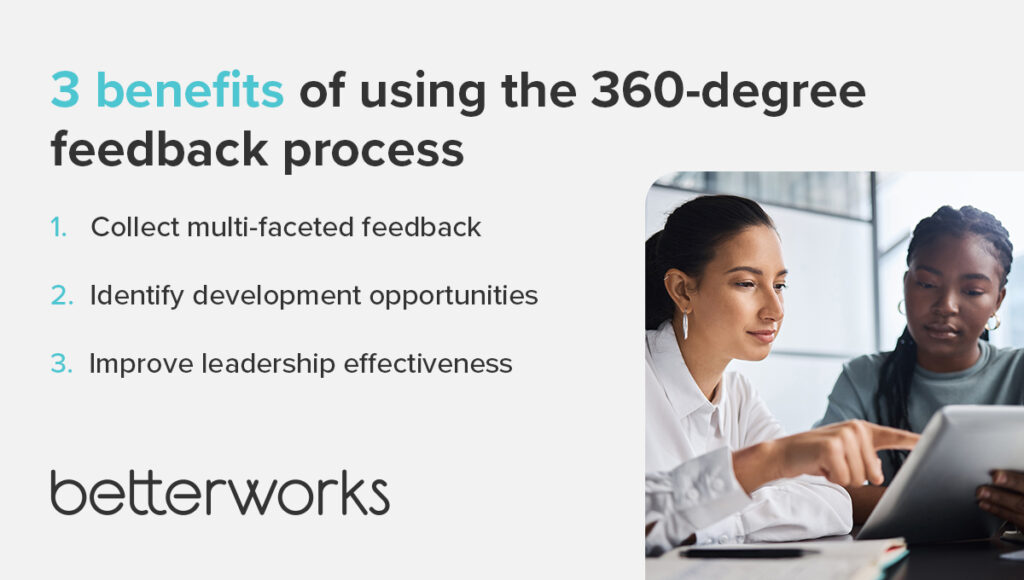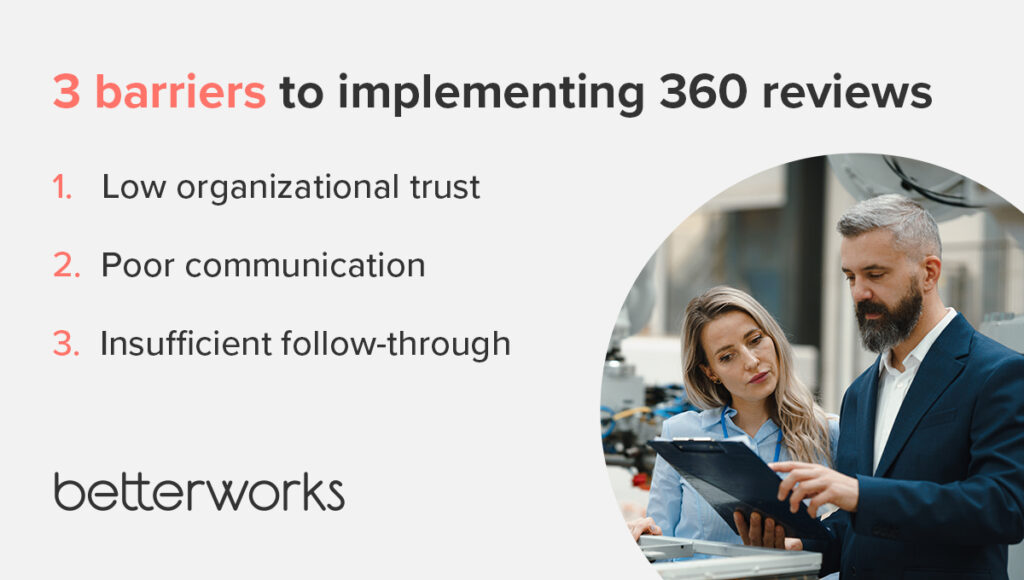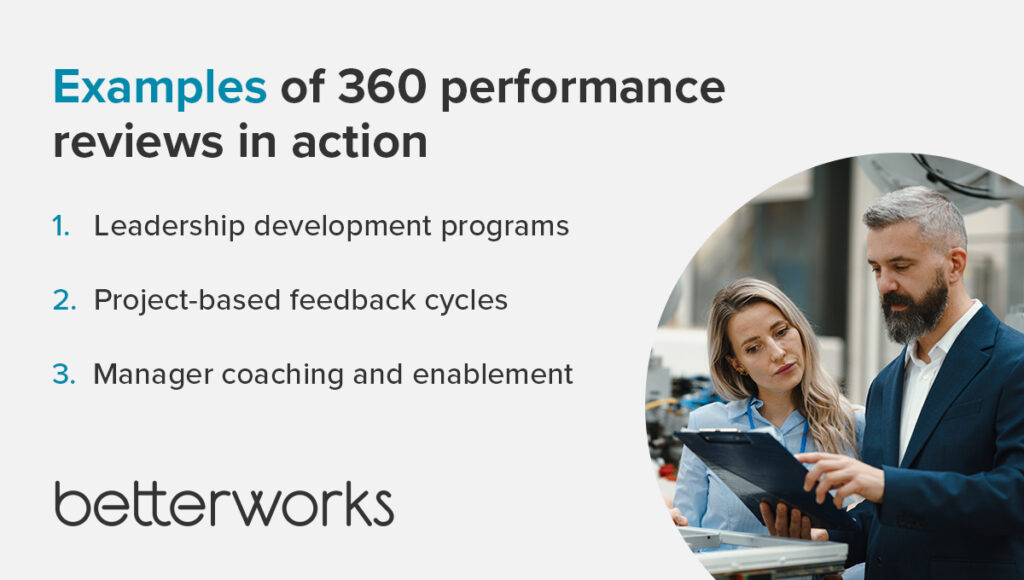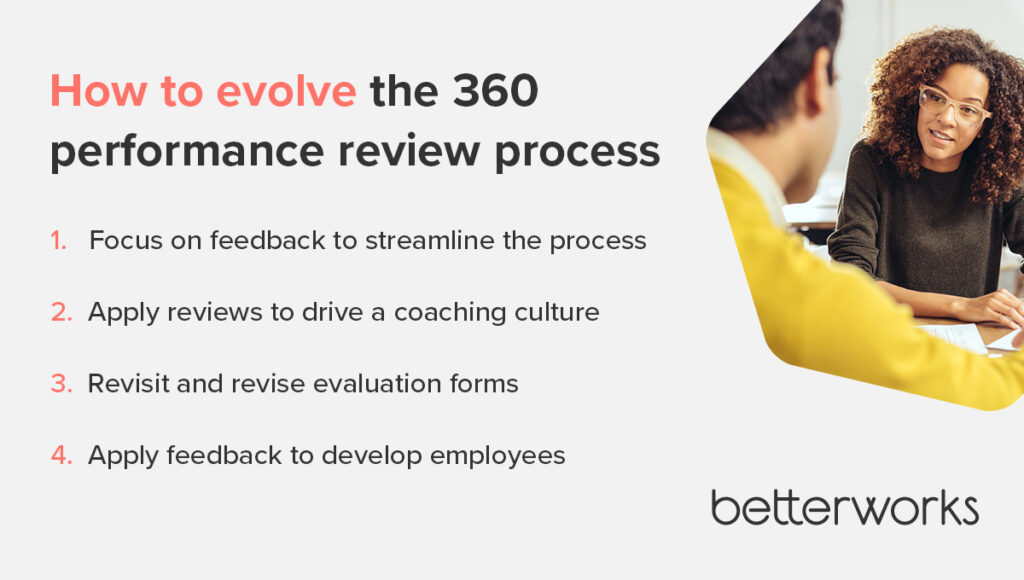- 3 benefits of using the 360-degree feedback process
- Drawbacks of the 360 review process
- 3 barriers to implementing 360 reviews
- Examples of 360 performance reviews in action
- LivePerson’s AI-powered approach to 360s
- How to evolve the 360 performance review process
- Drive progress through evolved review processes
What was once seen as a breakthrough in performance management, 360 performance reviews have, for many organizations, become a source of frustration. Despite the fact that they’re still widely used, they’re not always effective.
When applied with intent, 360s can uncover strengths, reveal blind spots, and support deeper leadership development. They’re especially effective when integrated into a culture of continuous performance conversations, not used as a one-off ritual.
The key is to focus on the process. When feedback is structured, guided, and tied to clear development goals, 360 reviews can drive growth and build trust across teams. Without that foundation, they risk becoming just another HR exercise that burns time without delivering outcomes.
3 benefits of using the 360-degree feedback process
Although managers are the primary source of performance feedback, they aren’t the only people who can bring valuable perspectives to the conversation. Here are a few benefits of applying 360-degree reviews in your organization.
Collect multi-faceted feedback
A 360-degree feedback process contributes to a comprehensive view of an individual’s performance by soliciting feedback from peers, supervisors, and other co-workers, not just the employee’s boss. This multi-rater feedback gives HR and managers insight into the interpersonal skills and team dynamics that shape the work environment. By combining multiple reviews and viewpoints, you can get a more complete and accurate assessment of each person’s strengths and areas for improvement. In practice, however, collecting feedback that accurately reflects each person’s contributions is often challenging.
Identify development opportunities
One of 360 performance reviews’ strengths is the ability to surface improvement opportunities that managers might not see. For example, teammates on a cross-functional team can share a perspective on an employee’s communication skills and collaboration with greater authority than the manager, especially if the manager wasn’t directly involved with a project. Some HR leaders believe pooling information from multiple sources enables managers to create development plans for their team members that are more useful and accurate.
This kind of constructive criticism helps employees grow and supports stronger performance appraisals that go beyond task-based evaluations. Peer feedback plays a critical role in highlighting behaviors that may not be obvious to a direct supervisor.
Improve leadership effectiveness
The 360-degree feedback process can help managers and executives by providing insights into their leadership style, communication skills, and ability to inspire and motivate others. Employees, especially direct reports, might not share this feedback otherwise. However, with a 360 review, this feedback can help leaders improve their impact while contributing to leadership accountability.
These reviews can be especially effective when conducted with small cohorts of employees, primarily leaders and executives. When a neutral party facilitates these reviews, company leadership can gain valuable perspectives they might not otherwise hear directly. In such cases, experienced executive coaches must help leaders process the feedback and develop action plans to improve their performance.

Drawbacks of the 360 review process
While 360 reviews provide some benefits when managing performance and developing employees, they can introduce some challenges into your performance evaluation process, too. Here are three drawbacks of using 360 performance reviews.
The process is time-consuming and costly
Conducting 360 performance reviews can be a time-consuming and costly endeavor. Each 360 review requires input from multiple sources to provide a well-rounded perspective on an employee’s performance. Coordinating and gathering these diverse inputs within a specific time frame requires synchronized efforts from various stakeholders.
Additionally, tailoring reviews for various job roles involves a nuanced understanding of specific competencies and skills relevant to each function. Parsing and understanding this highly specialized data requires more time and resources. This customization amplifies the overall costs and time investments associated with the process.
The feedback collected is inaccurate or biased
The 360 performance review process poses challenges that lead to inaccurate or biased feedback. Participants may rush through assessments due to the high volume of requests, jeopardizing thoughtful and accurate feedback for speed. This urgency heightens the risk of manipulation, prioritizing quick completion over delivering a comprehensive reflection.
Moreover, “relying on feedback requested at a specific moment in time introduces inaccuracy, as participants often depend on emotional memory rather than continuous observation of day-to-day actions,” says Caitlin Collins, organizational psychologist and Betterworks program strategy director. “It’s really influenced a lot by whether you like somebody — or you don’t,” she continues.
This reliance on emotional memory rather than continuous observation undermines the ability of 360 reviews to offer a fair and constructive feedback process. It also threatens employee engagement when feedback lacks relevance or credibility.
Inherent bias and poor follow-through
Despite HR’s encouragement of diverse perspectives, the combination of time constraints, point-in-time feedback, and mandatory participation heightens the risk of biased evaluations. Without follow-through, even well-structured 360 reviews lose credibility. Collecting feedback is only the first step. The real value comes from turning that feedback into coaching, development plans, and action.
3 barriers to implementing 360 reviews
There are several organizational factors that can make implementing 360 reviews a hassle. Here are some barriers to adoption you might encounter.
Low organizational trust
Without trust, your 360-degree feedback process could falter. Employees might fear retaliation for providing honest feedback, especially to leaders. If anonymity isn’t protected, employees may give generic or unrealistically positive feedback to avoid conflict, weakening the value of the process.
Creating a culture where team members are comfortable receiving feedback (both praise and constructive feedback) is foundational to making 360 reviews work.
Poor communication
If employees don’t understand the purpose and process of 360 performance reviews, they may not provide meaningful or constructive criticism. They might avoid offering honest, growth-oriented input for fear of damaging work relationships. Or they may not take the process seriously, viewing it as redundant alongside traditional performance reviews.
Organizations must clearly communicate the pros and cons of 360 performance reviews and how they differ from traditional performance reviews to gain buy-in and meaningful participation.
Insufficient follow-through
Without coaching support and visible outcomes, even the most comprehensive feedback loses impact. HR must help managers and employees turn peer feedback into action, development goals, and performance appraisals. Otherwise, the process becomes a feedback collection exercise that fails to support employee engagement or growth.

Examples of 360 performance reviews in action
360 performance reviews can add strategic value when tailored to specific goals or audiences. Here are a few examples of how organizations apply the process effectively.
Leadership development programs
In many organizations, 360 reviews are embedded into leadership development. Leaders receive multi rater feedback on their interpersonal and communication skills from peers, direct reports, and stakeholders. These insights become part of their individual development plans, reinforced by coaching and feedback tools.
Project-based feedback cycles
In matrixed or cross-functional environments, project-based 360 reviews offer a snapshot of how someone contributed outside their direct team. This format ensures feedback is timely and contextual. Open-ended questions can prompt more actionable insights.
Manager coaching and enablement
Some companies use 360s to gather positive feedback and constructive criticism from employees about their managers. With the help of HR, these insights guide coaching plans that align with organizational values and leadership standards.

LivePerson’s AI-powered approach to 360s
At LivePerson, performance reviews were reimagined through Betterworks and AI. Senior Director of Talent Development Deanna LaPierre and Talent Development Manager Matthew Meech introduced smarter 360s using AI Assist. The result: improved review completion, more constructive feedback, and better alignment with onboarding, probation, and performance cycles. This example showcases how feedback tools and innovation can modernize a traditional process.
How to evolve the 360 performance review process
Successful 360 performance review processes are planned, well-communicated, and thoughtfully implemented. Follow these steps to set up a 360 review process that supports your talent strategy and drives business results.
Focus on feedback to streamline the process
Teach people across the organization to provide constructive, growth-oriented feedback in real time and in alignment with your organizational structure. Capturing feedback at the right time and place increases its effectiveness in developing employees.
Building flows for capturing feedback throughout the year also contributes to a lighter lift for participants. By year-end, you’ll already have context for constructive feedback that reflects the full scope of each employee’s impact.
Apply reviews to drive a coaching culture
Encourage managers to engage in more frequent developmental conversations with their direct reports. Performance feedback should be used to understand context and perception, then coach employees toward improvement in targeted competencies.
This requires manager enablement. HR must train leaders to navigate feedback tools, analyze input from team members, and shape relevant, personalized coaching conversations.
Revisit and revise evaluation forms
Due to cumbersome evaluation forms, 360 review processes are often time-consuming. Get into the habit of reviewing your templates and ask: What are we using this question for? Are we collecting data we don’t use? What would it take to streamline this?
Reducing redundancy and focusing on the right questions — especially open-ended questions that invite useful, actionable feedback — make the process more efficient and aligned with real development needs.
Apply feedback to develop employees
Feedback that doesn’t lead to action creates frustration. “One of the most frustrating things for people is that very rarely does anything ever come of these 360s,” Caitlin says. “There’s no benefit; there’s no output.”
If you’re going to collect 360-degree feedback, you need processes in place to transform it into development. Managers must be trained to interpret results, have meaningful conversations, and support growth by co-creating development plans with employees.

Drive progress through evolved review processes
While 360 reviews have long been a staple of performance management processes, many organizations are now seeking to evolve their processes to focus more on continuous development and improvement. This evolution allows performance to be reviewed as an ongoing, dynamic process rather than a single annual event.
With the right guidance and training, managers can better use tools like 360 reviews to understand strengths and growth areas, and to tailor development goals for each employee. Making these changes to evolve traditionally cumbersome processes sets your organization up for higher engagement and more meaningful performance conversations.
Want to learn more? Check out The Employee’s Ultimate Guide to Giving and Receiving Feedback
Feedback matters. Learn how to give and receive it.



